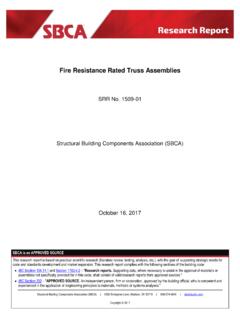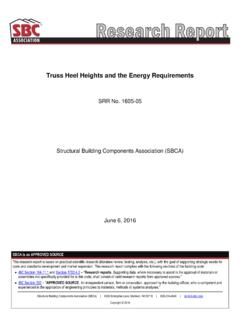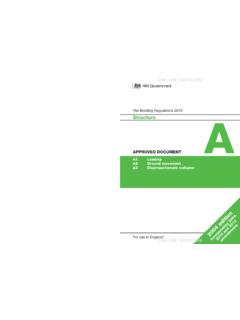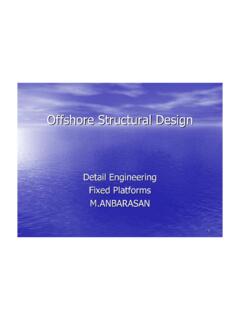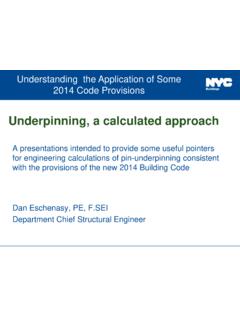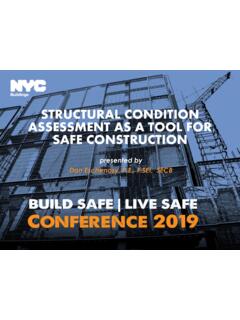Transcription of Fire performance of trusses - Structural building components
1 SECTION 17 fire performance OF performance - INTRODUCTIONF ireproof buildings do not exist. Even buildingsconstructed entirely of noncombustible materials cansuffer complete loss due to a fire started in the contentsof the building . The intention of fire performanceevaluation is to provide safe structures using reasonableand feasible measures, while taking into account aresponsible risk cost benefit assessment. The generalconsiderations of fire performance evaluation mustinclude all the following: Structural components ,exterior and interior finish components , buildingcontents, detection and alarm systems, exit design, fireprotection system (sprinklers), protection from adjacentbuildings or fire hazards, accessibility to fire -fighters,and the availability of fire -fighting localities have established geographic fire zonesrestricting the type of use or occupancy and type ofconstruction.
2 The goal is to reduce fire risk where firespread is likely due to the density of structures andwhere fire fighting would also be difficult. Most codesuse occupancy classifications to aid in determining firerisk. Setbacks and space around buildings is an issuein the ability of fire fighters to reach a burning structureand to limit fire materials used in construction two of the primaryconcerns are flame spread and fire resistance. Flamespread is a property of the material once fire has startedand building codes generally include tables givingflame spread ratings. These ratings are measured byASTM test E84. fire resistance is the ability of amaterial or assembly of materials to resist penetrationby fire or by heat transfer high enough to causecombustible material to be ignited on the other side ofthe assembly. The standard test for measuring fireresistance is ASTM test E119 and the time is given inhours or passive and active measures can be taken toimpede the spread of fire in a structure.
3 Fireblocking,draftstopping, and fire tested assemblies are passivedesign methods. Where passive design methods do notmeet the code requirements for protection of life andproperty, an active method is specified in the form ofa fire protection system, usually a water or chemicaldelivery system. Almost all current building codesinclude some form of fireblocking, draftstopping, andfire separation requirements, as well as fire protectionsystem implementation. Information regarding theuse of these measures are covered here only as generalprinciples. One must look at the local governing codeand the unique design requirements of the project forspecific implementations of these items. The issuesaddressed in this section, although specifically relatedto wood truss usage, can apply generally to all types ofmixed and light frame , inasmuch as the fire performance of trussescontinues to be an issue in the marketplace, WTCA hasworked with the Houston fire Department to developan educational CD and web based educational programthat takes a look at the truss industry from the fireservice's perspective.
4 For further information on thiswork, or if you have specific questions on fire endurance,visit our website at or pleasecontact , DRAFTSTOPPING AND FIREPROTECTIONF ireblocking and draftstopping are required bybuilding codes to control fire and smoke spread in theconcealed spaces of a building 's Structural components ,such as floors, walls, and stairs. Control prevents spreadof a fire by restricting movement of flame, gases andsmoke that accompany a fire . Control is desirable in allbuildings regardless of whether a building or itscomponents are classified as noncombustible, sincecombustibility of a building 's Structural components isoften not a major factor in fire is required in both vertical and horizontalorientations, like stud spaces at 10" intervals and atceiling and floor levels to prevent spread of fire in thevertical direction and by solid blocking of floor joistsover points of support and in some cases at partitionsand at soffits and dropped ceilings and similar locationsto prevent spread in the horizontal is usually provided by requiring aplywood or gypsum board barrier at 3,000 ft sq intervalsin attic spaces.
5 A horizontal area of 1,000 ft sq betweendraftstops is a typical requirement in non-residentialbuildings in floors. Multi-family buildings generallyrequire draftstopping in line with the dwelling unitsand tenant separations. The more constrictive floorrequirement is based on the rationale that the integrityof a floor is more critical than that of a roof and, therefore,open areas should be smaller in floor spaces than 17 fire performance OF TRUSSES17-2 The open areas between suspended ceiling and floor-ceiling assemblies and the open space created by floortrusses only require following draftstopping and fireblocking continuity through the space. No other specialprovisions are currently Forest and Paper Association (AF&PA) developed the following fireblocking and draftstoppingillustrations. In all cases, specific building code requirements in wood frame construction is illustrated in Figures - Generally, fireblocking shallconsist of 2" nominal lumber with broken lap joints or one thickness of 3/4" plywood with joints backed by3/4" plywood, or other approved - 5 Fireblocking is appliedat all interconnectionsbetween concealedvertical and horizontalspaces, such as insoffits (Figure ),drop ceilings ( ), and coveceilings ( ).
6 Figures & 2 Fireblocking inconcealed spaces ofstud walls andpartitions, includingfurred spaces, at theceiling and floor FRAMINGBALLOON FRAMINGSECTION 17 fire performance OF TRUSSES17-3 Figure inconcealed spacesbetween stair stringersat the top and bottomof the & 8 Fireblocking withnoncombustiblematerials at openingsaround vents, pipes,ducts, chimneys, andfireplaces at ceilingand floor 17 fire performance OF TRUSSES17-4 Draftstopping in floor-ceiling assemblies is shown in Figures - In buildings other than one-and two-family dwellings, draftstopping is placed in floor-ceiling assemblies so that horizontal areas do notexceed 1,000 ft is required in multi-family dwellings, motels, and hotels in the attic, mansard, overhang, orother concealed roof spaces above, and in line with, the tenant separation when tenant separation walls donot extend to the roof sheathing above (Figure ).
7 It is not, however, required in the attics of single-family dwellings. Draftstopping for multi-family dwellings, motels and hotels is not required whereapproved sprinklers are provided. In addition, where corridor walls provide a tenant separation, draftstoppingis generally required above only one of the corridor & 10 Draftstopping in thefloor-ceilingassemblies of one- andtwo-family dwellingswhere usable spacesare separated into twoor more approximatelyequal areas no greaterthan 500 ft sq In thesecases, draftstoppingshall be providedparallel to the mainframing formulti-familydwellings, motels, andhotels with floor-ceiling assembliesabove and in line withthe tenant separation,and tenant separationwalls that do notextend to the floorsheathing in multi-family dwellings,motels, and SeparationDraftstopTenant SeparationSECTION 17 fire performance OF AND TWO-HOUR RATED AREA SEPARATION ASSEMBLIESIt is of great concern when fire -rated assemblies are designed and specified without consideration of soundstructural principles.
8 Should a fire develop, these Structural inadequacies could cause the assemblies to failunexpectedly, increasing the risk of loss of life. The figures in this section provide sound Structural and fireendurance details that maintain rated area separation shows several possible assemblies that can be used to make up a one-hour rated system forseparation between occupancies for, a) floor trusses parallel to the wall assembly; and b) perpendicular to thewall assembly. A 2x4 fireblock is used between the walls next to the wall top plates. This effectively preventsthe spread of fire inside the wall cavity. A minimum 1/2" gypsum wallboard attached to one side of the floortruss system, and located between the floor trusses , also provides a draftstop and fire protection barrier betweenoccupancy spaces if a fire starts in the floor truss concealed space, which is a rare occurrence.
9 The tenant separationin the roof is maintained through the use of a 1/2" gypsum wallboard draftstop attached to the ends of one sideof the monopitch trusses and provided for the full truss height. This detail effectively provides one-hourcompartmentation for all the occupied spaces using listed one-hour rated assemblies and the appropriatedraftstops for the concealed spaces as prescribed by the model that can beused to make up aone-hour rated systemfor separation 17 fire performance OF TRUSSES17-6 Figure shows an alternative roof detail to that in Figure in which the roof trusses are parallel tothe wall assembly. In this case, a single layer of 1/2" gypsum wallboard is attached to the side of a single rooftruss in the location shown to provide the required draftstop and area a fire rated assembly, rather than draftstopping, is required within concealed attic spaces, the following detailsshow approved one-hour and two-hour rated assemblies that may be used in the roof cavity and that may beconstructed with gable end frames or - U3381 hour rated wall - bearing or non-bearing - withoptional insulation, with a finish rating of 20 minutesfor 1 layer of gypsum each side for non-bearingwalls or 59 minutes with 2 layers of gypsum eachside for bearing walls, on a single gable truss with2x3 2x4 studs spaced 24" max.
10 , - U338 Figure hour rated wall - bearing or non-bearing - withoptional insulation, with a finish rating of 20 minutesfor 1 layer of gypsum each side for non-bearingwalls or 59 minutes with 2 layers of gypsum eachside for bearing walls, on a double gable truss with2x3 2x4 studs spaced 24" max., effectivelyfireblocked. The septum sheathed with plywood ormineral/fiber board is optional in the - U339 Figure - L5542 hour rated load wall with optional insulation, nofinish rating given, with 2 carrying parallel chordtrusses spaced 6-3/8" apart and webbing spaced16" vertically, with one layer of 5/8" gypsumboard one side each truss and either 15/32" or 19/32" sheathing on roof carried on a 2 hour ratedconcrete block wall.(Note that the UL drawing is not clear as to theexact installation details)Figure - U339 Figure - L554 SECTION 17 fire performance OF TRUSSES17-7 THE CRITICAL ASPECTS FOR fire ENDURANCE ASSEMBLIES INCLUDE: Ensuring that the wall and ceiling assemblies of the room use one-hour rated assemblies.

